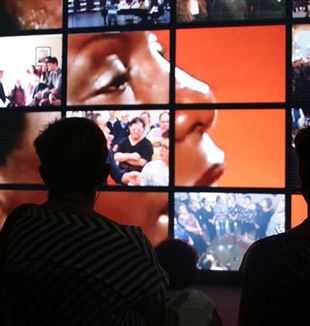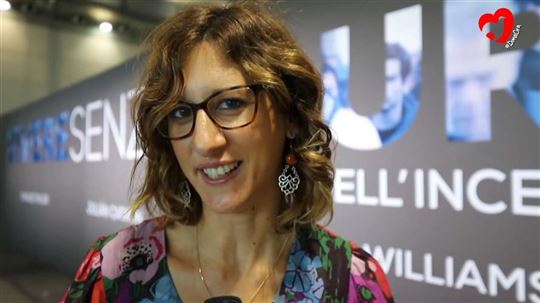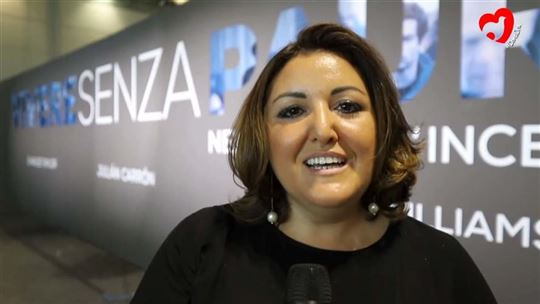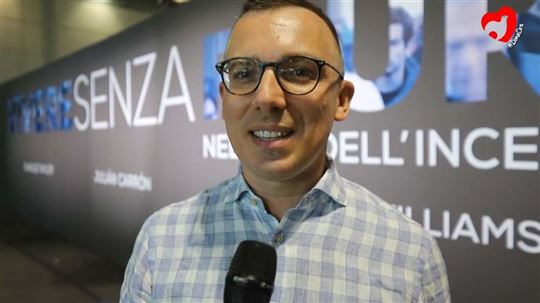
Immersed in the world
"Living Without Fear in the Age of Uncertainty". The exhibit from the Meeting on secularization was born from the story of a friendship, that looks at the world without censoring anything. From October Traces.Meeting of Rimini, Pavilion B3. The big screen of the third “room” displays the quotation of Fr. Giussani stating, “I am not able to find another index of hope if not the multiplication of
these persons who are a presence. The multiplication of these persons and an inevitable sympathy between them.” The audiovisual exhibit Living Without Fear in the Age of Uncertainty has finished. At the exit, Alessandra Gerolin, Pia De Simone, Alessandro Rovati, and Samuele Busetto–young professors of philosophy and curators of the exhibition–await the visitors. A man approaches them. “Recently, my son told me something about himself that was a scandal for me, a sign of my educative defeat. The exhibit helped me understand that I can look at this situation as something more than a condemnation. I desire to stay in front of him and his needs, which are so deeply human. Today is the beginning of a new journey.” Some weeks later, a friend who had seen the exhibit from home called Samuele, who is a professor of philosophy in Treviso, saying, “Thank you for the work you have done. I perceived the same ‘ineffable and total vibration’ that seized me in my encounter with the Movement and that is the only thing capable of waking me up.” Messages and conversations of this kind continued even after the week in Rimini. “There was a superabundance of humanity that is almost inexplicable. I am understanding more and more that this is not something we own or do. The Lord is working in a mysterious way. It was more than the work of our own hand,” recounts Alessandro, director of the department of Theology at Belmont Abbey in North Carolina.
But what lies at the origin of this work that moved and continues to move the humanity of so many people? A friendship, “an inevitable sympathy between them,” that has been present since the beginning. In October of 2019, Charles Taylor, professor emeritus of philosophy at McGill University in Montreal, was in Rome to receive the Ratzinger Prize. For Alessandra, a professor of moral philosophy at the Catholic University of Milan, it was an occasion to reconnect with the Canadian philosopher. They had met in 2015 in the Italian capital during a conference, and Taylor, with great curiosity, had wanted to accompany her to the audience of Pope Francis with the Movement. Seated on the steps of Saint Peter’s plaza he had said: “If I understand well, all of this was born from the friendship between a priest and some young people.” 
Together with Pia, a friend and currently a professor of ancient philosophy at Trier in Germany, Alessandra invited Taylor and Carrón to dinner. The two had an intense dialogue that converged into two main points: Christianity is not a collection of rules, but rather, is useful for living, and secularization is an immense opportunity to verify the nature of our need and to rediscover the nature of the faith. “From what you are telling me, you live that which I speak about academically. It would be beautiful to communicate it to the public at large,” said Taylor at a certain point. “It would be wonderful if the Meeting had an exhibit on these themes,” Alessandra proposed rapidly. “Yes, let’s try to get something going,” was Carrón’s response. Thus, the exhibit was born out of an exchange of words during dinner that lasted a maximum of forty seconds.
Pia and Alessandra invited Samuele and Alessandro to join them. They are connected by a friendship that began at the Catholic University of Milan, where they were involved with the experience of the Movement, that brought them to encounter–at Oxford and Cambridge–the great intellectuals of the Anglican world. The way these thinkers lived Christianity fascinated them. Among them was Rowan Williams, then the Archbishop of
Canterbury. His was a name that during the dinner had been mentioned “due to his fascinating position in front of reality,” says Alessandra. 
The working group became larger, coming to involve two Canadian friends: Kirsten Gfroerer and Aaron Riches. The pandemic hit, and Zoom sessions followed, some between the curators and others with Carrón, Taylor, and Williams. They were dense dialogues for many reasons, including, as Pia explains, “because of the perception that they had of reality and their gaze full of tenderness for man.” The work proceeded with the selection of keywords, beginning from the phenomenon of secularization: freedom, humanity, fullness, hope, desire...These became the foundation of the interviews with the three interlocutors and were the basis for the organization of the exhibit. As Pia remembers: “We had thought of the standard panels with quotations from poets, writers, maybe the choruses of some songs, in order to document what they had told us. But instead….” They began to ask the opinion of some experts. Then, a friend, himself a theologian, provoked them: “Who reads the panels these days? You need to create an immersive exhibit. Video. Play the songs that young people dance to nowadays, the new psalms of the twenty-first century. Give it a try.”
This suggestion was the turning point. They stopped pursuing confirmation of their ideas, instead simply accepting the challenge: to communicate a gaze on the present moment that is capable of embracing the questions of everyone. And they saw that the response to those questions was present within reality. “We discovered that in every expression, even the most extreme, there are elements of the irreducibility of the human that nothing can rip away; there is a desire for fullness that no institution or rule can exhaust,” Pia continues. Slowly, the exhibit took form. The idea of panels left in the dust, the new format became three videos in which Carrón, Taylor, and Williams, speaking about themselves and their encounter with Christianity, dialogue with reality through image and film clips, TV shows, and songs. Nothing is excluded. The words “freedom,” “hope,” and “humanity” became faces that speak, shriek, and seek. When Samuele happened upon a video of a transsexual who was speaking about his experience, he thought: “He has within himself the same desire for fullness that I do.” Only a few months earlier, he would have moralistically categorized that existence as the fruit of a failed education or of a society on the edge. “With a gaze like this, secularization is already defeated,” Alessandra says. Or, better, it becomes “a vocation, the invitation of God who invites us to enter into a new profundity of relationship with Him and with the world,” as Williams said
during their talk at the Meeting. 
For their project, they asked their friend Massimo Bernardini, an author and television director, and his son, Matteo, for a hand. Both proposed the director Giulia Sodi. “The encounter with them was fundamental,” Samuele continues. “Giulia asked for an explanation for everything. She left no stone unturned.”
A year and a half of work ensued in the personal lives of each person involved in the project. The three months before the Meeting were the most difficult for Alessandra. During the day, she worked and took care of her sick father, while during the evening she prepared the exhibit. “When I read the title after opening the file, I asked: But is this true for me? What allows me to live without fear, to live with hope?” Her father died on the Sunday of the Meeting. “I thought: how fortunate He is to be looking upon the One for Whom we are searching this week. I was filled with a gladness and gratitude that I had not expected.” 
When the Jewish communities of Gastonia and Charlotte asked Alessandro to organize an event on interreligious dialogue, he proposed meeting every two weeks to read the texts of the two religions on the theme of living without fear. “The gaze full of curiosity that I had been living in the preparation of the exhibit helped me to stay with them full of questions.” This event ended up happening. “But that which is most dear, that which I bring home with me, is a friendship. One that continues.”
The news of the exhibit went beyond the borders of Italy, and friends in the Moscow community decided to add Russian subtitles. Some weeks later, an Orthodox priest of the Donetsk region, which is contested by Russia and Ukraine, asked: “Can I share this video with the people of my region? It will help us to face the tragic situation that we find ourselves in.” On the last day of the Meeting, a young boy, glued to his smartphone, followed his parents as they visited the exhibit. When they arrived at the second “room,” he looked up at the big screen and saw his favorite rapper. He turned toward his older brother and asked him for the headphones that accompany the exhibit. The image changed, but he did not give back the headphones until after the last section of the presentation, including the final credits.
“Forget your perfect offering,” sang Leonard Cohen in a song that accompanied the final video. “Forget the idea that reality must be ‘correct.’ I do not need to change it to be able to offer it to others. I can simply look at it in its entirety,” Samuele says. And therein lies the challenge of this exhibit.